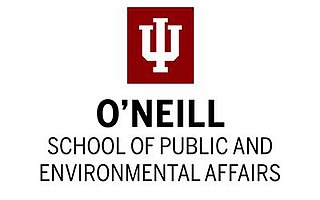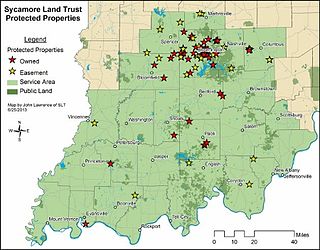Vicky J. Meretsky | |
|---|---|
| Nationality | American |
| Alma mater | Cornell University |
| Scientific career | |
| Fields | Conservation Biology, Ecology, Statistics |
| Institutions | Indiana University Bloomington |
Vicky J. Meretsky is an American professor and Director of Environmental Masters Programs at Indiana University Bloomington.
Meretsky received a Bachelor of Sciences at Cornell University in 1980. In 1988, she completed her first Master's degree in Wildlife Ecology at Humboldt State University in Arcata, California and pursued a second Master's degree in Statistics from the University of Arizona in 1993. She completed her Doctorate in 1995 at the University of Arizona, where she studied the foraging ecology of Egyptian vultures in the Negev Desert. [1]
Meretsky is currently a professor at Indiana University Bloomington (IUB), teaching: conservation biology, how climate change impacts on natural resources, and graduate statistics. She has held several adjunct positions in various departments since she became an affiliated faculty member in 1998. Previously, Meretsky taught as an adjunct professor at the University of Arizona from 1996 until 2001.
Outside academia, she has worked as a consultant and specialist for outside universities and governmental organizations, including wetlands consultancy for the Department of Justice. Before her employment at IU, she worked for the U.S. Fish and Wildlife Service as a research biologist studying endangered species and ecosystem management in the Grand Canyon.
Meretsky’s work focuses on both the science and policy aspects of conservationism, studying the effects of anthropogenic climate change on single species as well as broader impacts on ecosystems and whole regions. Her interests include, but are not limited to, "conservation planning, ecology of rare species, integrating ecosystem and endangered species management with adaptive management, and impacts of climate change on each." [2] She sits on the advisory board of the Sycamore Land Trust in Indiana. [3] She has spent time studying numerous species within and outside the US, including Egyptian vultures, the humpback chub, and the California condor and was involved in measuring the effects of the insecticide DDT on condor reproduction. [4]
Meretsky is a five-time winner of the Trustees Teaching Award at IU, three-time winner of the Teaching Excellence Recognition Award, and three-time winner of IU's School of Public Environmental Affairs (SPEA) Outstanding Teaching Award. In addition, she has received several grants for her continued research, including two EPA-funded National Lakes Assessment grants as well as a $400,000 teaching grant from the Department of Education for the funding of a US-Russia Global Environmental Issues Research and Study Program. [5]

Habitat conservation is a management practice that seeks to conserve, protect and restore habitats and prevent species extinction, fragmentation or reduction in range. It is a priority of many groups that cannot be easily characterized in terms of any one ideology.

An oak savanna is a type of savanna—or lightly forested grassland—where oaks are the dominant trees. The terms "oakery" or "woodlands" are also used commonly, though the former is more prevalent when referencing the Mediterranean area. These savannas were maintained historically through wildfires set by lightning, humans, grazing, low precipitation, and/or poor soil.

Ecological restoration, or ecosystem restoration, is the process of assisting the recovery of an ecosystem that has been degraded, damaged, or destroyed. It is distinct from conservation in that it attempts to retroactively repair already damaged ecosystems rather than take preventative measures. Ecological restoration can reverse biodiversity loss, combat climate change, and support local economies.

Elinor Claire "Lin" Ostrom was an American political scientist and political economist whose work was associated with New Institutional Economics and the resurgence of political economy. In 2009, she was awarded the Nobel Memorial Prize in Economic Sciences for her "analysis of economic governance, especially the commons", which she shared with Oliver E. Williamson; she was the first woman to win the prize.

The Paul H.O'Neill School of Public and Environmental Affairs is the public policy and environmental studies school of Indiana University with locations on both the Bloomington and Indianapolis campuses. It is the largest and highest-ranked public policy and environmental studies school of its kind in the United States. Founded in 1972, as the Indiana University School of Public and Environmental Affairs, it was the first school to combine public management, policy, and administration with the environmental sciences. O'Neill School Bloomington is the top ranked school of public affairs in the United States. The school received a facelift and expansion when the Paul O'Neill Graduate Center opened for classes in the Spring 2017 semester due to the growing influx of students. In 2019, the name was changed to the O'Neill School of Public and Environmental Affairs in honor of alumnus Paul H. O'Neill who served as the United States Secretary of the Treasury in 2001–2002.

Translocation is the human action of moving an organism from one area and releasing it in another. In terms of wildlife conservation, its objective is to improve the conservation status of the translocated organism or to restore the function and processes of the ecosystem the organism is entering.

The Indiana University Maurer School of Law is the law school of Indiana University Bloomington, a public research university in Bloomington, Indiana. Established in 1842, the school is named after alumnus Michael S. "Mickey" Maurer, an Indianapolis businessman who donated $35 million to the school in 2008.

Sycamore Land Trust is a 501(c)(3) non-profit member-supported land trust headquartered in Bloomington in the U.S. state of Indiana.
William Wallace (Wally) Covington is an Emeritus Regents' Professor of Forest Ecology at Northern Arizona University (NAU), and the Emeritus Founding Director of the Ecological Restoration Institute at NAU. Covington is known for his research and outreach activities on conservation, forest health, fire ecology, and ecological restoration, drawn from his research since 1970 on the ponderosa pine, aspen, dry mixed conifer, and pinyon-juniper forests and woodlands of the West, particularly those that surround Flagstaff, Arizona. He has been called perhaps the nation's most visible forest scientist, by Science magazine.

Gretchen C. Daily is an American environmental scientist and tropical ecologist. She has contributed to understanding humanity's dependence and impacts on nature, and to advancing a systematic approach for valuing nature in policy, finance, management, and practice around the world. Daily is co-founder and faculty director of the Natural Capital Project, a global partnership that aims to mainstream the values of nature into decision-making of people, governments, investors, corporations, NGOs, and other institutions. Together with more than 300 partners worldwide, the Project is pioneering science, technology, and scalable demonstrations of inclusive, sustainable development.
A vulture restaurant is a site where carrion, decaying flesh from dead animals, is deposited in order to be consumed by vultures, and is sometimes referred to more generally as supplemental feeding or provisioning. These stations can also be referred to as vulture feeding sites, vulture feeding stations, and vulture safe zones. This supplemental feeding practice is used to provide vultures with reliable, non-contaminated food sources or to aid in monitoring schemes. Vulture restaurants have been instituted as a method of vulture conservation in Europe and Africa since the 1960's and 70's, when vulture populations began to decline. This strategy is used because often population declines are attributed to low food availability, food contamination or insufficient nutritional quality, or feeding from human areas leading to conflict. Notably, large vulture population declines in South Asia, referred to as the Asian or Indian vulture crisis, and Africa, referred to as the African vulture crisis, have brought renewed attention to the uses and impacts of vulture restaurants. Vulture restaurants are used in Asia, Africa, Europe, and North America for various conservation and management plans. They can help combat food-derived threats to vultures, such as diclofenac or lead contamination or conflict with ranchers and poachers. The first vulture restaurant was built in South Africa in 1966. Vulture restaurants operate in a number of countries, including Nepal, India, Cambodia, South Africa, Eswatini, and Spain.
Ellen D. Ketterson is an American evolutionary biologist, behavioral ecologist, neuroendocrinologist and ornithologist best known for her experimental approach to the study of life-history trade-offs in a songbird, the Dark-eyed Junco. She is currently a Distinguished Professor of Biology, Director of the Environmental Resilience Institute, and affiliate professor in Cognitive Science, Gender Studies, Integrative Study of Animal Behavior, and Neuroscience at Indiana University.
Robert L. Fischman is the George P. Smith, II Distinguished Professor of Law at the Indiana University Maurer School of Law in Bloomington, Indiana. He is also an adjunct professor at the Indiana University School of Public and Environmental Affairs.

Susan Lynn Williams was an American marine biologist and Distinguished Professor of Evolution and Ecology at the University of California, Davis, where she directed the Bodega Marine Laboratory from 2000-2010. She researched marine coastal ecosystems and how they are affected by human activities. She was a strong advocate for environmental protection, credited with helping pass legislation expanding the boundaries of Northern California's Gulf of the Farallones and Cordell Bank national sanctuaries, increasing the area of federally-protected coastal waters.
Nancy Huntly is an American ecologist based at Utah State University, where she is a Professor in the Department of Biology and director of the USU Ecology Center. Her research has been on biodiversity, herbivory, and long-term human ecology. She started her position at USU in 2011, after serving as a Program Officer in the Division of Environmental Biology at the National Science Foundation. Prior to that she was a faculty member in the Department of Biological Sciences at Idaho State University (Pocatello).
Erika S. Zavaleta is an American professor of ecology and evolutionary biology at the University of California, Santa Cruz. Zavaleta is recognized for her research focusing on topics including plant community ecology, conservation practices for terrestrial ecosystems, and impacts of community dynamics on ecosystem functions.
Kimberly A. Novick is an environmental scientist and an Associate professor at Indiana University, Bloomington. Her research mostly includes the study of land-atmosphere interactions. She received the Thomas Hilker Early Career Award in Biogeosciences from American Geophysical Union (AGU) in 2019.
Leah R. Gerber is a conservation biologist and environmental scientist most known for her contributions to the field of biodiversity conservation. She has conducted research on population ecology, conservation decision-making, and the application of innovative quantitative methods in conservation biology.
Ashley H. Moerke is an American ecologist and a professor at Lake Superior State University. Her research focuses on freshwater ecosystem management, especially around the Great Lakes. Moerke advises local and state governments and bi-national commissions on water science, fisheries, and other environmental issues. In 2020, she was chosen as president-elect of the Society for Freshwater Science.
Damayanti Buchori is an entomologist and land use ecologist, currently based in Bogor, Indonesia. She is a professor, researcher, non-profit director, and an ATBC honorary fellow.